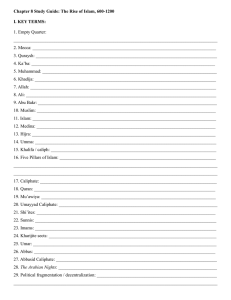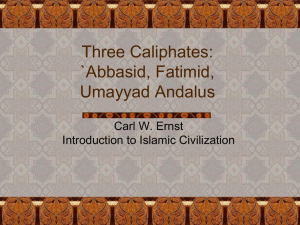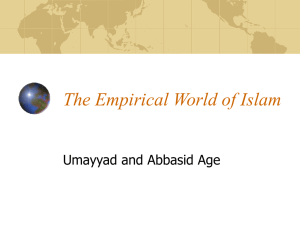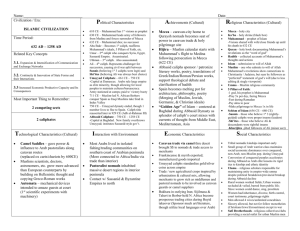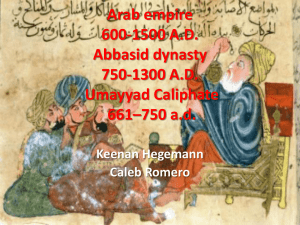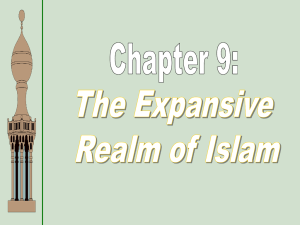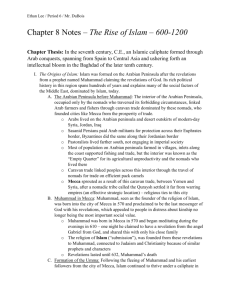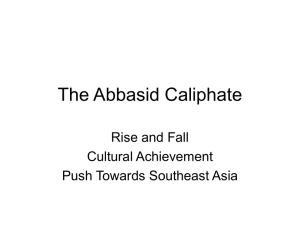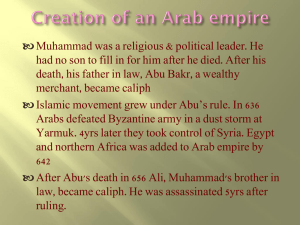Chapter 8 Rise of Islam
advertisement
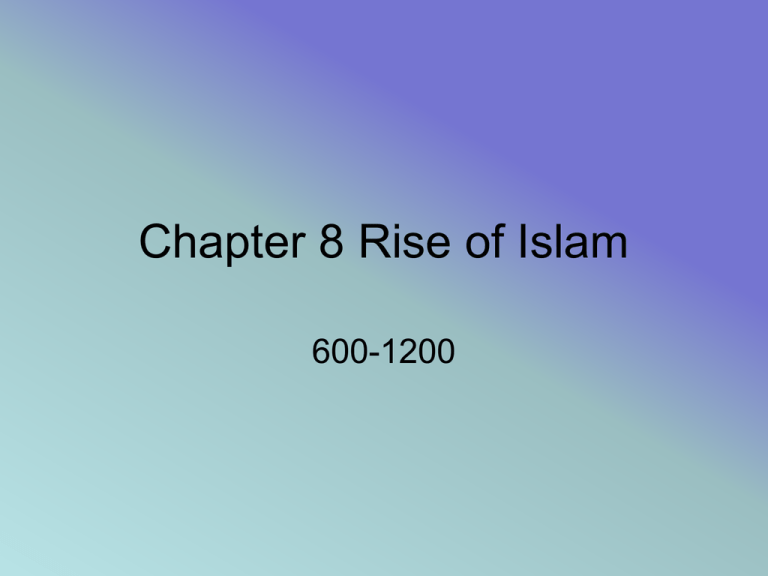
Chapter 8 Rise of Islam 600-1200 The Origins of Islam • The Arabian Peninsula Before Muhammad • Muhammad in Mecca • The Formation of the Umma The Arabian Peninsula Before Muhammad • The Arabs in 600 CE lived usually in the Arabian Peninsula, Syria, Jordan, and Iraq • It was in these Arab lands that Islam took its shape • Nomads in these lands gained income from providing camels, guides, and safe passage through their land The Ka’ba • A shrine, the Ka’ba, contained idols • Killing was prohibited • Some people who lived in Mecca affiliated the shrine with stories of the Christians and Jews • They believed Abraham was the man who built the Ka’ba Muhammad in Mecca • Born in Mecca in 570 • One night, while meditating, Muhammad was spoken to by the angel Gabriel who told him revelations about their Lord • He shared his revelations at first only with close friends and family • He claimed to hear the words of God The Formation of the Umma • Muhammad- threat to leaders • Muhammad and his followers fled to Medina in 622; this marks the beginning of the Muslim calendar • The Meccan migrants in Medina bound themselves into a Umma • Umma: a community defined solely by acceptance of Islam and of Muhammad as the “messenger of God.” 5 Pillars of Islam -Belief in one God -Prayer 5 times a day -Paying alms, -Fasting -One pilgrimage to Mecca in a lifetime Qu’ran Civil War • Umma disagreed regarding the succession to the Caliphate • After the assassination of the 3rd caliph, civil war struck • Rebels from the army nominated Ali to be the new caliph The Umayyad Caliphate • The Umayyad Caliphate started when Mu’awiya chose his son to succeed him • The Shi’ites believed Ali was the rightful successor and that Ali’s descendants should succeed him • The Sunnis considered the caliphs to be cover ups • They revolved into Kharijite sects who claimed honor for themselves alone The Fall of the Umayyad Caliphate/ Start of Abbasid • The family of Abbas, an uncle of Muhammad, took over and established the Abbasid Caliphate • The Abbasid Caliphate held power until 1258 Political Fragmentation • The Abbasid Decline became apparent in the middle of the 9th century as the conversion to Islam increased • Keeping up with a vast empire wasn’t easy • The empire was so big that they couldn’t control the people or get word across to other parts of their empire without difficulty Arab Forces • During expansion, Arab forces were organized into regular, paid armies • Kept military camps and military towns so they didn’t overrun the countryside • Arab Muslims became minority-rulers • Didn’t try to convert conquered people Literature and Learning • Thrived under the Abbasids • Translated the Greek texts and secular Arab poetry • Baghdad was the center of the Abbasid culture • Acceleration of the rate of conversion of non-Muslim subjects to Islam at this time Decline of Abbasid Power • 2nd half of the 9th century as the caliphs found it nearly impossible to maintain control over their vast empire • Factors: - difficulty of transportation and communication -dissatisfaction of non-Muslim populations Result of Decline • 9th century local results carved the Abbasid realm into smaller Muslims states Baghdad • Caliphs in Baghdad relied on Turkish slave troops called Mamluks • Later in the 9th century, Mamluks were not paid properly The Fall of the Abbasid Caliphate • 945- Caliphate under control of Iranian Shi’ite people • Abbasid Caliphate declined • Various provincial regimes rose to power -Samanids in Bukhara -Fatimids in Egypt Political Diversity • Underlying the political diversity of the fragmented Muslim world was a strong sense of religious identity preserved by the religious scholars: The Ulama Assault from Within and Without • In Central Asia and the Middle East, a nomad group called the Seljuk Turks took advantage of the decline of the Abbasids to establish the Suljik Sultanate • They ruled a territory that stretched from Afghanistan to Baghdad Collapse of Baghdad • Their collapse was caused by: -Substantial urbanization -Introduction of citrus crops -Diverse irrigated agricultural sector Crusades • The Crusades put some pressure on the Islamic lands • There were further invations by: -Turkish in 1250 -Mongols in 13th century Islamic Civilization • Law and Dogma Hadith • Most important source of law was the traditions of the Prophet (Sunna) as revealed in the reports (hadith) about his words and deeds • Islamic specialists on law reviewed tens of thousands of hadith Converts and Cities • During early expansion converts to Islam needed to learn about their new religion Urban Life • Variation in urban social and religious life was due to no central authority to prescribe religious dogma Academic Advances • Significant advances in medicine and astronomy Islam and Women • Muslim women were veiled and secluded • They could be influential in the family, but only slave women could have public appearance • Muslim men feared women committing sexual infidelity or meddling in politics Rights of Muslim Women • • • • • Right to own property Retain property in marriage Right to divorce and remarry Right to testify in court Right to go on pilgrimage Islam and Slaves • Muslims were not permitted to enslave their fellow Muslims, Jews, Christians, or Zoroastrians. (exception: only when taken as prisoners of war) • Muslims could and did hold non-Muslim slaves, but the status of slaves was not hereditary Recentering of Islam • Decline of Caliphate= no Islam religious center • During the 12th and 13th centuries, two sources of religious authority developed: – Madrasas (religious colleges) – Sufi brotherhoods Activity • Directions: Match the number and letter that go together. • For example, if #1 is letter C, you would write: 1.) C • • • • • • • 1. Abbasid Caliphate 2. Umayyad Caliphate 3. Mecca 4. Abraham 5. Ka’ba A. a shrine containing idols B. started when Mu’awiya chose his son to succeed him • C. believed to be the man who built the Ka’ba • D. where an uncle of Muhammad, took over and established this Caliphate • E. the city where Muhammad was born
